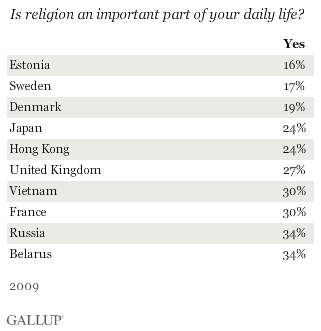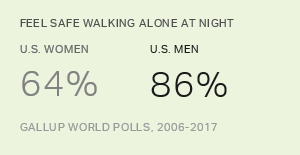WASHINGTON, D.C. -- Gallup surveys in 114 countries in 2009 show that religion continues to play an important role in many people's lives worldwide. The global median proportion of adults who say religion is an important part of their daily lives is 84%, unchanged from what Gallup has found in other years. In 10 countries and areas, at least 98% say religion is important in their daily lives.

Each of the most religious countries is relatively poor, with a per-capita GDP below $5,000. This reflects the strong relationship between a country's socioeconomic status and the religiosity of its residents. In the world's poorest countries -- those with average per-capita incomes of $2,000 or lower -- the median proportion who say religion is important in their daily lives is 95%. In contrast, the median for the richest countries -- those with average per-capita incomes higher than $25,000 -- is 47%.

The United States is one of the rich countries that bucks the trend. About two-thirds of Americans -- 65% -- say religion is important in their daily lives. Among high-income countries, only Italians, Greeks, Singaporeans, and residents of the oil-rich Persian Gulf states are more likely to say religion is important.
Most high-income countries are further down the religiosity spectrum. In 10 countries, no more than 34% of residents say religion is an important part of their daily lives. Six of those are developed countries in Europe and Asia with per-capita incomes greater than $25,000.
In three of the four lower income countries on the list -- Estonia, Russia, and Belarus -- the Soviet government restricted religious expression for decades until the U.S.S.R.'s collapse in 1991. The final country is Vietnam, where the government also has a history of limiting religious practice.

Implications
Social scientists have put forth numerous possible explanations for the relationship between the religiosity of a population and its average income level. One theory is that religion plays a more functional role in the world's poorest countries, helping many residents cope with a daily struggle to provide for themselves and their families. A previous Gallup analysis supports this idea, revealing that the relationship between religiosity and emotional well-being is stronger among poor countries than among those in the developed world.
Visit Real Clear World's Top 5s feature to learn more about the countries with the highest religiosity.
For complete data sets or custom research from the more than 150 countries Gallup continually surveys, please contact SocialandEconomicAnalysis@gallup.com or call 202.715.3030.
Survey Methods
Results are based on telephone and face-to-face interviews conducted in 2009 with approximately 1,000 adults in each country. For results based on the total sample of national adults, one can say with 95% confidence that the maximum margin of sampling error ranges from ±5.3 percentage points in Lithuania to ±2.6 percentage points in India. In addition to sampling error, question wording and practical difficulties in conducting surveys can introduce error or bias into the findings of public opinion polls.

